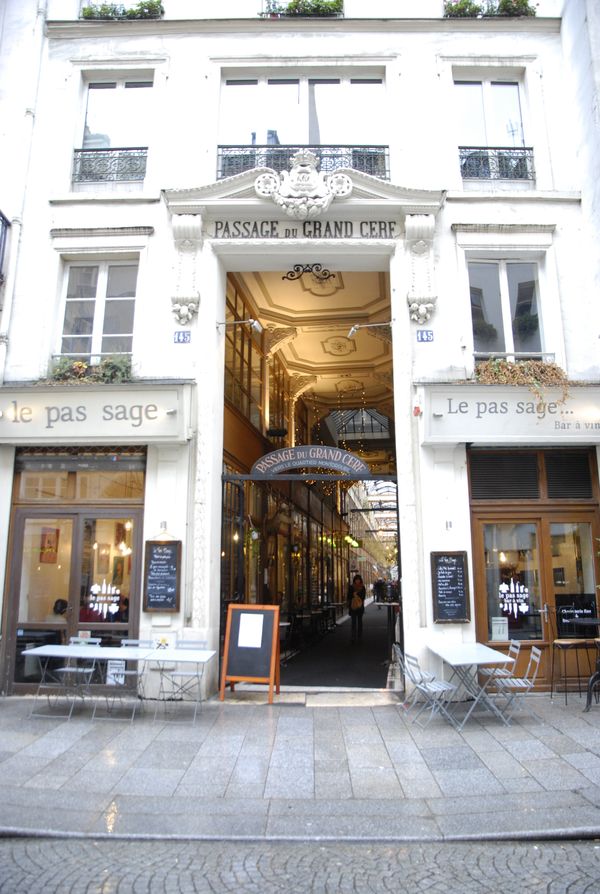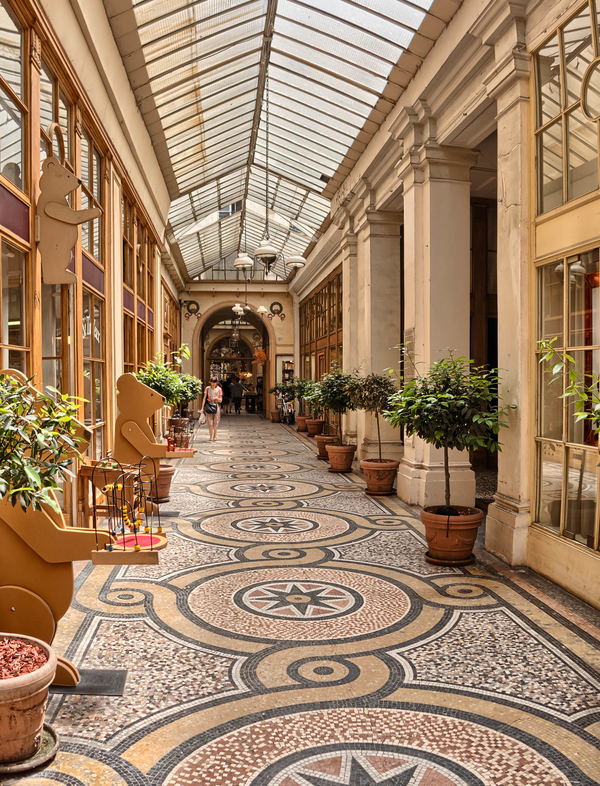Welcome to the Passage du Grand Cerf!
It’s one of the prettiest covered passageways of Paris, tucked away in the second arrondissement. This iron and glass arcade from 1825 houses 20 or so boutique shops and businesses, a few offices, and apartments.
The Passage du Grand Cerf, like many other hidden Paris passageways, is many things. It’s a private shortcut through the narrow Parisian backstreets; it’s a shelter from the rain and the elements; it’s a quiet place to shop and wander. And in essence, that’s what it’s always been: a space for Parisians to cut across the city, to do some window shopping, and to go about their day without worrying about a sudden downpour.
Suffice it to say that the passageway itself is almost the same as it was in 1825—it’s the rest of Paris that’s changed.

History of the secret passages
The Passage du Grand Cerf used to be one of a network of more than 150 passageways providing a welcome respite from the hostile rues of post-revolution Paris.
In 1825, when it was built, the surrounding streets were dark and dirty. Roads were not paved, and there was no waste collection or sewer system. In the rain, the streets became a mire of human, horse and household muck!
The streets at that time were also narrow, winding, and difficult to navigate, often ending in a random cul-de-sac or a dangerous dead end. Paris was still in political turmoil after the Revolution, so clashes between the lower classes and the controlling forces created pockets of violence and crime.
The passageways provided respite from daily life in 19th century Paris. They were areas of pleasure: paved interior streets, lined with boutiques, sporting decorative facades. Plus, they were covered from the elements—and the contents of the morning chamber pot!
At the end of each passage there was a short hop over a muddy street and allez-hop! into the next. They created another world: a peaceful place for a stroll, sheltered from the hurly-burly of street life.

Window shopping, then and now
The covered passageways changed the lives of everyday Parisians. People could navigate the city more quickly: delivering messages, attending to business and getting to and from work.
More importantly, the passageways granted a social space in a city inhospitable to middle-class women. Now they could leave their homes without running the risk of ruining their long skirts.
Window shopping also became a leisure activity. The flaneur—a French literary figure who wanders around the city, drifting from shop window to street corner with no real purpose—also made his first appearance. The role of the flaneur is to be, to observe, to take it all in. And that’s what we’re still doing in these easy-to-miss arcades in the first, second and ninth arrondissements.
Come for a wander, do your own bit of window shopping, and stop for a drink in one of the many great bars and restaurants in this picturesque setting that welcomes wanderers from all over town.
Here’s our list of the most beautiful hidden Paris passageways.

The most beautiful hidden Paris passageways
Note: Passageways and galleries are privately owned. They are generally closed on Sundays, and after 10 p.m. throughout the week.
1. Passage du Grand Cerf
In this passageway, all the shops are unique. There’s a bespoke glasses shop, still in the same spot since 1880; a boutique with rustic decorations for home and balcony (we’re in Paris, remember); a jeweler working on a handmade collection; and a savonnier, an artisanal soap shop, with soaps made in every color, scent and substance imaginable. Even the pork fat soaps smell surprisingly good.
Foodie find: Skip over to GAG (which stands for gras—a.k.a. fat—alcohol and gluten), situated in neighboring Passage du Bourg Abbé, for a great selection of natural and biodynamic wines and great home-cooked food.

2. Passage des Panoramas
This is one of Paris’s oldest passageways, which opened in 1800. It’s also arguably the busiest. The many restaurants that have made this passage home provide a bazaar of signs and smells, color and activity.
Foodie find: Check out Coinstot Vino, one of the oldest natural wine establishments in the city. Expect an education with your glass! Or if you’re after something a bit different, pop into Adar, a fusion of Middle Eastern flavors cooked up by some of Paris’s most promising young chefs.

3. Galerie Vivienne
One of the more visually impressive passageways—complete with mosaic floors, murals and a recently restored glass roof—this passageway is home to high-end fashion brands. Galerie Vivienne has been the location for many a Jean-Paul Gaultier fashion shoot, and even a runway show or two. This passage also boasts a couple of art galleries and antique shops—perfect for window shopping, or picking up a signature French piece of your own!
Foodie find: Stop off at Legrand Fils et Filles, a wine bar established in the 1880s, with more than 300 references. Peruse their épicerie—a kind of general store of fine produce—and pick a bottle straight off the shelf to enjoy in their luxurious shop.

4. Palais Royal
The original covered shopping experience in Paris is le Palais Royal just next to the Louvre. At the time of its inception in the late 18th century, this gallery was a hub for artists, writers and thinkers of the day. The ground floor was home to shops and artists’ studios, whereas the entresol (the beautiful arched windows between the ground and the first floor) was a hub for women practicing the oldest trade in the world!
These days, soaring rent prices mean that a lot of the shops are converted into offices or indeed empty. However, the space still makes for a peaceful stroll in some grandiose 18th century galleries and gardens, a stone’s throw from the Louvre. It’s also worth visiting for its beautiful garden alone.
Foodie find: Just around the corner, step into Willi’s Wine Bar, opened by Anglophone wine enthusiasts in the 1980s. Here, you’ll find an enormous selection of French classics, and food served all day.
5. Galerie Vero-Dodat
This is the shortest passageway on our list, but in no way the least important. Its neoclassical style, black and white tiled floor, and marble columns make it uniquely luxurious and charming.
The private art galleries, high-end fashion stores and stamp specialist shops give this passageway a rare feeling between the dusty and forgotten, and the upmarket sleek. It’s a one-off place, with a totally unique feeling.
Foodie find: Keeping one foot firmly in the past, step into le Café de l’Epoque, a traditional French brasserie still with its original tiled floor, zinc bar and antique mirrors. Despite its proximity to the Louvre, this brasserie manages to keep its authentic feel. The place is usually packed full of both locals and very French waiters serving tiny glasses of wine.